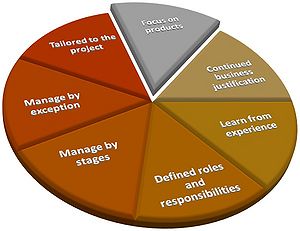Projects in Controlled Environments, a process-based approach for project management
Developed by Fabrizio Ferraresi
Project Management is a field based on a conspicuous level of uncertainty, the use of appropriate methods and tools influence the risk reduction of project failures. In this article we are going to illustrate the so-called PRINCE2 method, focused on processes and continue viability control. PRINCE2's relevance in this subject is bilt upon its universal nature, which let it be used from every type of organization for every project typology.
The implementation of this methodology, apart from pledge to stay on time and within the budget, is able to ensure a perfect control, coordination and implementation of the project. Making this possible through a close and continuous communication and a high integration within each part of the work. [1]
Contents |
Overviews
First established in 1989 by the Central Computer and Telecommunication Agency (CCTA) [1], the second version of this PRoject IN Controlled Environment, hence PRINCE2, it is now owned by a stable public authority, the Office of Government Commerce (OGC), and is available free of charge in the public domain. It moves its first step in UK standardizing the project management system of the government in order to improve delivery of their services; now it has become a valuable project tool for any type of organization.
PRINCE2, apart from allows more efficient control of development resources, gives controlled management of change by the business (its investment and ROI) and an active involvement of the final product's users throughout its development. This to ensure that the output of the project will meet the functional, service and management requirements of final users[2].
The seven Principles
The method is grounded over seven principles. Everyone of them can be apply to every kind of project, they are also self-validating and they are empowering, so they are able to give at users the capacity to shape the management of the project[3].
The sine qua non condition to turn a project into a PRINCE2 project is to adopt all of these principle to it.
Focus on products
The product is the core of the project: every aspects from planning, risk management, responsibilities, configuration of the management, to control and quality requirement are product-based.
Following this principle, a project needs to be output-oriented instead of activity-oriented. Its purpose has to be to meet the interest and the expectation of the different stakeholders, together with the business justification. In order to make this possible, a mutual awareness of the entire products required, and them quality prospect is essential.
The lack of such a fundamental principle can led the project to major risk like rework, uncontrolled change and user dissatisfaction.
Continued business justification
This principle is based on the assumption that a project should not start until it has a worthy Business Case behind; the project, thus, must be aligned to the business objectives of the organization. A Business Case should be done by first, as it will act as driver for the decision-making processes[3].
From the moment that a project must have continued business justification, if this change (it may occur event that vary the justification itself, for any kind of problem or obstacle encountered during the stages of the project) it’s essential that the justification remain valid anyway.
As mentioned earlier, the Business Case is essential for the business justification of a project, it’s the main way in which the organization can control if the work fulfil this first principle.
Learn from experience
Project management should never consider a project as a new world, as something that can not be applied to previous experience of the organization. It’s fundamental to learn lesson from the past and use them as a support for future works. Furthermore, it’s essential that every time something unexpected happened, lessons from this need to be recorded and acted upon all the life cycle of project, and used for future ones: seek opportunities during the work of a project could implement improvement.
Defined roles and responsibilities
Projects involved people, PRINCE2 possesses well-defined and agreed responsibilities and roles within an organization structure that involve, together, user, business and supplier stakeholders’ interest. To ensure a positive output of the project, the interests of all the three stakeholders must be represents effectively in the project management.
This principle aim to create a solid management team for the project that can put together the various parties involve for the achievement of a common goal. The project, therefore, need to involve the right personalities over the organizations, if it does not happen or if the people do not understand the role they have each other it will end up in a failure[4]. Creating an effective organizational structure for the project is vital to its success.
Manage by stages
Derived from the consideration that, several time, happen that a project last longer than the time expected and calculate at its very beginning, this principle come also from the necessity to have, during its execution, key point for reviews[3]. These to allow the senior management to control if the progresses follow the prospect and if they are still on the idea of continuing the project.
PRINCE2, thus, divided the project into stages; the duration (and, therefore, the number) of which may vary from different works: the shorter they are, the more control they offer, the longer they can be mean less energy and participation from the board. In this way the management plans only the next stage from the output of the previous one, so to be able to be more specific and lower the risk and the possibility to fail.
As outcome of every stage, a plan is presented and the Business Case updated, so to have a project monitored, planned and controlled stage-by-stage[4].
Manage by exception
A PRINCE2 project has specific tolerances for each objective, in order to establish boundary of the authority delegated. The method thus recognized different levels in the project management; each of them has different tolerances within which it can continue to run its power without ask the upper level’s intervention. Is possible to identified tolerances against six limit[3]:
- Time: plus or minus an amount of time on the target completion dates.
- Cost: plus or minus an amounts of planned budget.
- Quality: plus or minus degrees off a quality target.
- Scope: Permissible variation of the plan’s products.
- Risk: Limits on any individual threats or on the plan’s aggregated risk.
- Benefit: plus or minus degrees off an improvement goal.
This principle allow a high reduction of problem referrals or superfluous meetings: as long as any tolerance does not exceed its limit PRINCE2 let a management level to continue its work. The next level is involved only when there is a forecast of a tolerance being exceeded.
Tailored to suit the project environment
PRINCE2 is a method tailored to suit all project’s aspects. The action of adapt the method to the specific situation, thus, has to be undertaken before its launch.
The principle aim to ensure that the project management actions are associated to the specific environment where it takes place, and the project controls are built around its complexity, scale, competence, importance and risk.
This assure the universal attitude of PRINCE2: it can be used for any project from the moment that the method is designed to be tailored to its specific needs[4].
The Structure
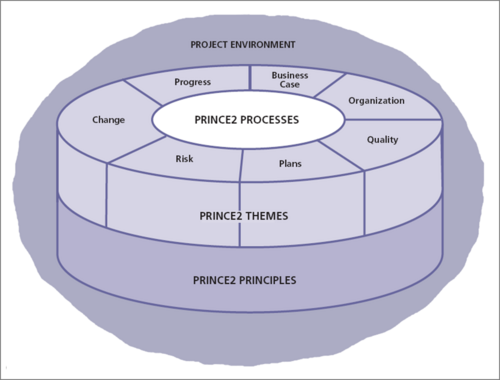
- PRINCE2 offer a set of Processes that make its user able to have control over every stage of the project;
- It possesses seven Themes that explain its way of acting throughout all the aspects of the project;
- This method do not put emphasis on which Techniques need to be used; it offers only few of them and them use is optional, making exception for the “product-base planning” one.
Process
Thinking about a process as a structured set of activities design to accomplish a specific purpose[4], hence the process model consist in the main part of PRINCE2. It takes the user from the very beginning to the conclusion of the project through each stage of which is made of[5]. The structure sketch by processes are not linear: some of them will run in parallel and, very often, a block it’s repeated to ensure the better output possible. All of them are aligned to the management level of programming, directing, managing and delivering.
Every project using PRINCE2 must to address to all the processes in some form. Doing so the main action is not to use them as standard ones, but tailoring each of them to the specific work environment.
The steps of project management are defined by these processes:
Starting Up a Project
The purpose of this firs process is to ensure to have a viable and worthwhile project to work on, to find, thus, if it possess all the prerequisites it needs to be opened.
The activities of Starting Up are to[2]:
- Appoint the Executive and the Project Manager who will form the PM team - the Executive should have strong links with the Board, he also might be part of it - this is essential to create the ideal working environment;
- Understand if previous experiences in other projects might be applied to the new one for preventing possible mistakes;
- Identifies the approach that will be used to evaluate the stage of the project and to find solutions to be provided to problems: the project approach will shape the duration and the costs of the project as well as its quality;
- Prepare the Business Case in order to ensuring if the expense of the project is justified.
- Identifies the customer’s quality expectations;
- Create a Risk Log and fill it in with any risks already known or discovered;
- Plan the initiation stage: this to create the foundation of the project and to prepare the document to get the approval for its start.
Initiating a Project
This process has purpose to understand the work that will be done to delivered the project’s outcome before committing to a weighty spend, the benefits that are expected from it and the associated risks. It needs to ensure that all the parties intended to achieve a common goal and how to achieved that specific goal, doing so, this process lay down the basis for a successful project.
Initiating a Project is the union of different activities such as:
- The definition of the strategy to cover the quality reviews and how it has to be made;
- The plan for the project in its entirety, so when and how its outcomes will be delivered and at what cost, and how communication between all the interested actors will be established;
- The definition of the people to be involved in the decision-making and problem solving actions;
- The outline of how every project’s progress will be checked and monitored;
- The tailoring of corporate project management method for suiting the project.
This process end up with the draft of the Project Initiation Documentation, a collection of documents that will be used in future stage to compare the performance against the original expectation.
Directing a Project
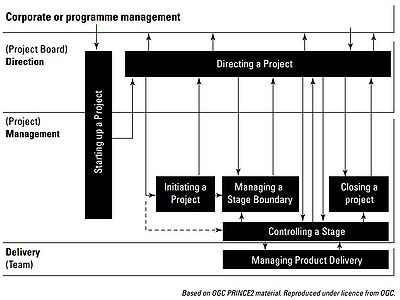
The process is aimed to the senior management team which are the final decision-maker[2]. It is, thus, really important that different levels of authority need to be undoubtedly identified.
Its purpose is to enable project board to be responsible for the project’s success while delegating day-to-day management to project manager: it has to authorized every step of the project (from the initial business justification to the control end of the work) and to direct and monitor it throughout its life so to assure its viable nature. PRINCE2 help the board doing so by adopting the principle of Management by exception: it controls by a limited number of predetermined decision point, and they are inform from the lower level of exception that might occur.
This process start as a conclusion of starting up and runs until its completion and doing[2]:
- Authorization for project initiation;
- Provides connection between corporate and program management;
- Advises the Project Manager of any external business events that could cause variation in the project;
- Approves Stage Plans and its conclusion;
- Decides on changes to approved products;
- Approves possible Exception Plans;
- Gives ad hoc advice, in addition to direction, during the project;
- Safeguards the customer’s interests as well as the one of the supplier;
- Approves project closure.
Controlling Stage
This process aim to manage every stage from its approval to the completion. It assigns works and monitor them, and it face possible problem taking corrective actions towards them and, finally, report progresses to the Board.
Controlling Stage guarantees that every work come together with its quality expectation, and its target, delivery and reporting dates. Every possible predictable source of issues is here checked. Furthermore, the process gathers information to update the plan for next stages in order to follow the actual progress and its connected quality.
The final object of the process is to produce highlight report to be seen by the project board, thus to eliminate futile meetings.
Managing Product Delivery
Under the responsibility of the team management, this process agrees with work requirement with the project manager and actually does the work. It must report about progress and quality checking and when it has been accomplished the process need to confirm if it had respect the expectations.
Managing a Stage Boundary
It basically ensures that the approval for passing to the next stage subsist or if it necessary to open an exception plan; therefore it has to provide to the Board evidence for the ongoing viability of the project. It does so by enabling the Board to be provided with essential information from the project manager. So to review the correct execution of the current stage and to approve the stage after, confirming the business justification and risks’ tolerability.
It can happens that a stage had exceeded the tolerance; here the Board may ask to repeat the same stage with a different planning from the original one. While if everything went properly the process need to prepare the plan for the next stage.
Closing a Project
When the project manager together with customer and supplier agreed that the project has accomplish all the objectives set out in the initial stage, it must be brought to a reasoned close.
In this final process it’s checked if all the products required have been successfully delivered and if the first objectives have been met; it also reviews if and how the final performance differ from the original idea.
The project close with the transfer of the ownership of the outcome to the customer, and expiration of the project management team’s responsibility.
Themes
What give strength to this method is the specific treatment that it provides to themes: they are wisely conceived to link together in the most effective way possible, and, consequently, all seven are always integrated. The actions of every theme involves almost every process of PRINCE2.
As already stated, also in the case of themes they must be addressed to every specific project in a proper way, hence appears again the concept of tailoring according to specific characteristic (scale, complexity and nature of the environment).
Business Case
It is the instrument used to verify continuously if the project possesses the request viability, prestige it had in its first steps. It ensures that the work remains achievable, in order to be supported from decision-maker and its continued investment[4]: it has to be worth doing.
The Business Case, as management products, is one of the most significant and it owns to the project Board. It outlines the reason behind a project, it foresees expected costs and benefits and its whole timescale; PRINCE2, following its product-based nature, focusses on the costumer’s Business Case. It also underlines the main risks that the project might meet. On its inside it comprehends a document which explain when benefits will be measured, how and by whom.
This need to be review firstly at the start of the project, at every stage boundaries and lastly at the project conclusion. Thus to constantly check if the work can to be justified.
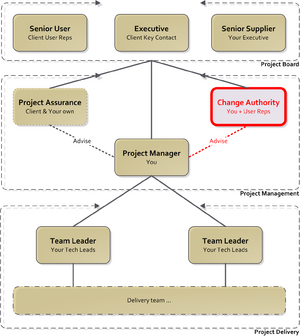
Organization
This theme is aligned with the above-mentioned “Defined roles and responsibilities” principle, it aims to build an effective organizational structure, able to maintain its power throughout the project’s life; it's fundamental for the success of a project.
A project’s organization must represents the interest of the three parties involved: the Business, the User and the Supplier. It also needs to put together an effective strategy to manage the flow of communication between the three stakeholders.
A PRINCE2 typical organization if made up by these figures:
- Project Boar that provides and handles all the final decision-making power, therefore it’s responsible for the success of the project. The board approves every major plans and them possible deviations. Here the Executive, together with the Senior User and the Senior Supplier, are the principal responsible for the project.
- Project Manager who effectively run the project with a day-to-day approach, following the direction of the Board. He must check if everything, concerning the product or service, are arranged to happen with the entire requirement needed.
- Team Manager is a role that appear not in all PRINCE2 project (in these case his tasks are done by the Project Manager). It is the delegated in charge of produces some certain products with detailed characteristics, outputs that need specific knowledge or skills.
- Project Assurance a delegated role whose aim is to monitoring all the aspects of the project that are independent from the Project Manager, such as maintaining the right link between the supplier and the customer during all the life of the project.
Plans
It’s likely to be impossible running a project without a plan. For PRINCE2 a Project, a Stage and, in some cases, an Exception Plan are mandatory. The method stated that every plans should start with the acknowledgment of all the outputs or the products required from that plan.
The Project Plan - created at the beginning of the project - let the Board know about its estimated duration, its main products or deliverables and its main risks and quality standards.
For the Stage Plan the concept is almost the same of the Project one but it made for a lower level of application, for day-to-day control. Planning one stage each time makes the work easier.
Every time a project run over the pre-conceived tolerances an Exception plan need to be made, and this require the action of the upper management level.
Progress
This theme aims to ensure control over several main points of the project, here it measures the achievement of its objectives. Progress acts as monitor and control for actual accomplishment against those planned at the start, furthermore it provides goals forecast for future stages of the project base on the actual ones.
Therefore, Progress controls the evolvement of risks, time, cost, quality, scope compared to the target, and it uses this data to make choice for future action.
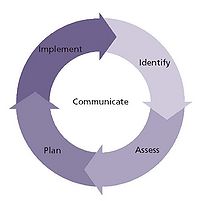
Risk
To improve chances to succeed of the project it must be identify, assess and control uncertainties: here this theme play is role. Consequently, risk management should be systematic and proactive.
Its procedure is composed of five steps: identify, assess, plan, implement and the final communication.
Risk Management’s activity will last during all the lifetime of the project (so to keep going with the update of the Risk Log); a good affective of it is the base for the principle of Continued Business Justification.
Quality
It warrants for the generation of proper products from a projects, so to cover all the expectations made. PRINCE2, using ISO definition of quality, check if the acceptance criteria are been met before the final user’s approval of the products.
It has to start from the Costumer’s Quality Expectation and it continues throughout all the lifetime of the project with Project Quality Plan that fixed how the project it is going to meet the Customer’s Quality Expectations. Moreover, at every stage, with a Project Quality Plan which contains a lower level of detail than the previous one.
Change
Control over possible changes is a compulsory action to bring the project in on schedule and to budget. This is not something to prevent, from the moment it could bring positive outcome for the project, a change control need to be. The authority over change control and acceptance is over the Board of the project.
Techniques
PRINCE2 techniques are not mandatory. A company may already have, e.g., a quality checking technique, which it wishes to use in preference to the PRINCE2 quality review. Although it actually does not give more information about which technique to use and when, it puts emphasis on two of them:
Product-base planning
Projects deliver products, thus them must be the most important part to focus over. It affirms that all the activities, which form a project, are to be built upon the idea of the required product. This technique required the construction of a Product Breakdown Structure[2], which capture the hierarchy of the products that the project required to produce: on its top there is the final output of the project, and at every lower stage there are all the constituent parts of it, from the most important to the units.
Product-based planning has three components:
- Product Breakdown Structure: hierarchical structure of all the products that need to be produce or needed by the plan, at the top of which there is the final outcome;
- Product Descriptions: every step in the previous hierarchical structure need a proper description of the product itself which underline its purpose, composition, the quality criteria and the quality method that need to be applied to it, and the derived products necessary for its construction. The description’s draft forces the management to consider if there is a sufficient knowledge to produce the product, and moreover, is a vital checklist to be used for the quality check of each stage.
- Product Flow Diagram: map of the sequence in which the products have to be produced and the dependencies between them. It is the stage after the Product Breakdown Structure.
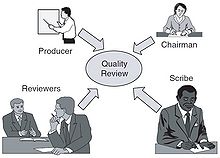
Quality Review
This technique does not belong to this method but it’s one of the very few which PRINCE2 give information about.
Quality review is based on fixed meetings that aim to find possible errors, and it does that through the check of paper-based output such as reports [5]. It is a team structured method of reviewing products by running a meeting on the review to ensure that all expectations are properly covered.
The technique made this possible by inspections of products in a planned, independent, controlled and documented manner and ensure that any errors are found and fixed as early as possible[2].
As an indirect consequence, the quality review also spreads knowledge of the product among those whose own products may interact with it.
Benefit
The truly generic nature of PRINCE2 it’s the first aspect that makes it one of the most used method in project management. This can be used for helping any type of project, no matter its dimension, its organization, its culture or geography.
This is made possible through a focus of the proper aspect of the project itself and not to the management’s ones: the specialist aspects run in parallel and in integration with the method but they do not affect directly it. This attribute gives to the method the ability to be used, by any organization, as a standard to improve their maturity and capability over several areas of their business, from R&D to IT and so on. [4]
The use of PRINCE2 bring with him numerous benefit to the project and, therefore, to the organization that stands behind:
- Its action of dividing the project into stages makes the project itself much more easy to manage.
- It lets the project team to stay focused and delivers a quality outcome at the end of the day.
- It improves communication, both between all members of the team and between the team and other external stakeholders, thus to enhance the control over the project.
- It gives the stakeholder decision-making power, as they are always kept informed by the regular reports.
- As just said it could be apply to any kind of project, and, furthermore it does not need the presence in the project of specialist; PRINCE2 can be implemented alongside them.
- It makes possible to everyone to know all the responsibilities and all the roles that act in the projects.
With all these points, it’s possible to say that PRINCE2 promote learning and continual improvement in organizations.
Limitation
The first limitation of PRINCE2 is about its complexity. As you have seen, it’s made of several parts and activities, and without a specific training about its usage and its mechanisms it impossible to be implemented in a project. Moreover, the possible failure to understand specifically how it works could bring a lot of problems and difficulties during the life of the project.
It must be said also that with the growth of project management to a different level, especially in the IT and software company, PRINCE2 does not offer the level of flexibility offered by some of the modern project management methodologies (e.g. SCRUM); it may find difficulties in covering and satisfy some of the modern project management needs.
PRINCE2 could lead to negative effects if implemented in organizations that want a standard approach to planning and controlling projects: a fixed (and not tailored) used of the method, a part from being difficult, could likely bring to failure, because of its bureaucracy and its long implementation. This is not a specific limitation but highlight a problem of a wrong interpretation of the methodology.
Thinking about the active part of the methodology it can be argue that PRINCE2 generates too much “paper” and need to much action: following its rules, the different management levels communicate through a conspicuous number of documents (it may be for highlight the situations of the project or control/registration of risks). Furthermore every one of the processes sketched by the method must be undertaken. This should, in some cases, be seen as a limitation from the moment that useless or unnecessary documents or unnecessary action, which usage might not be clear, are built. Consequently, this can delay the decision-making process.
Conclusion
Looking both at the benefit and the limitation of this method, it comes to the eyes how its application could really help an organization facing the growth and the development of a project. Doing so by organizing and scheduling every aspects and building the proper structure around it.
Every company - especially medium and large ones - able to put the right weight to every work they need to deal with, and with the right sense about how things have to be organized would only receive positive outcomes from using PRINCE2 method.
References and Annotated Bibliography
- ↑ 1.0 1.1 Prince2 100 Success Secrets - The Missing Foundation and Practitioner Exam Training, Certification and Project Management Guide, 2008, Gerard Blokdijk, Emereo Pty Limited.
The book addresses the top 100 consultancy & education forum questions, with tips & success factors on investigating, evaluating, attaining & capitalising on Prince2 (Projects in Controlled Environments) Project Management certification. - ↑ 2.0 2.1 2.2 2.3 2.4 2.5 2.6 2.7 PRINCE2™ A Pratical Handbook (Third Edition), 2010, Colin Bentler, Elsevier Ltd.
The book illustrates how using PRINCE 2 can provide a business-like start to a project, ensuring its viability and the effective use of resources before any large-scale expenditure is undertaken. - ↑ 3.0 3.1 3.2 3.3 PRINCE2™ Revealed (Second Edition), 2010, Colin Bentler, Elsevier Ltd.
The book is a perfectly readable, end-to-end overview of the complex PRINCE2 method that starts from a more accessible level going, then, deeply inside the subjects. - ↑ 4.0 4.1 4.2 4.3 4.4 4.5 4.6 4.7 Managing Successful Project with PRINCE2™, 2009, Office of Government Commerce, TSO.
This manual describes the PRINCE2 project management method providing detailed guidance, a clear step-by-step guidance on applying PRINCE2 to achieve effective project management and measurable business benefits. It depicts how to set up, organize, manage, control and deliver projects on time, within budget and to the right quality. - ↑ 5.0 5.1 5.2 PRINCE2 For Dummies, 2010, Nick Graham, Wiley.
This book takes the reader through every step of a project - from planning and establishing roles to closing and reviewing - offering practical and easy-to-understand advice on using PRINCE2. It also shows how to use the method when approaching the key concerns of project management. The guide provides to users with a comprehensive guide to its systems, procedures and language so you can run efficient and successful projects. - ↑ Project Management in Practice, http://prince2msp.com/2011/05/21/can-i-control-scope-and-keep-stakeholders-happy/.
